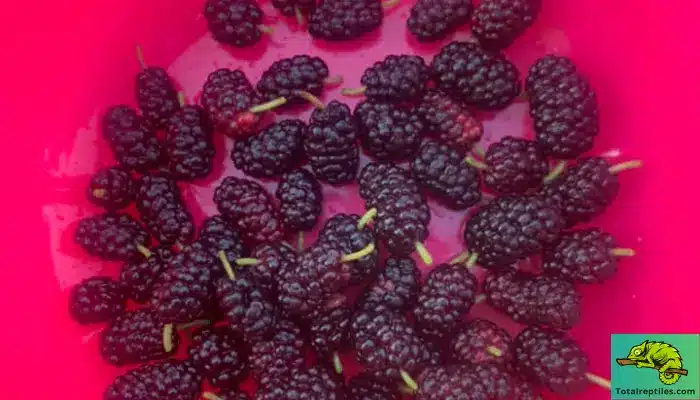Good and bad news about mulberries. Beneficially, these berries include vitamin C, iron, and calcium. However, they include sugar and water, which can harm beardies. Calcium-to-phosphorus ratio dominates. Beardies need a 2:1 ratio for healthy bones and growth.
So you have a bearded dragon and want to give it a tasty and nutritious snack. Mulberries seem like they could be a good option. Those juicy, purple berries look like something a bearded dragon would relish. But can bearded dragons eat mulberries? Is it safe and healthy for them? That is a very good question!!
I’ll walk you through everything you need to know about feeding mulberries to bearded dragons. Together, we’ll figure out if these sweet berries can be part of a happy diet!

Nutritional Value of Mulberries
When it comes to fruits, mulberries are quite nutritious! Here are the Nutritional values based on information from the USDA Food Data Central:
| Nutrient | Amount |
| Calories | 43 kcal |
| Water | 87.68 g |
| Protein | 1.44 g |
| Carbohydrates | 9.80 g |
| Dietary Fiber | 1.7 g |
| Sugars | 8.10 g |
| Fat | 0.39 g |
| Vitamins & Minerals | |
| Vitamin C | 43.0 mg |
| Vitamin K | 7.8 µg |
| Calcium | 39 mg |
| Phosphorus | 38 mg |
| Potassium | 194 mg |
| Magnesium | 18 mg |
| Iron | 1.85 mg |
| Zinc | 0.12 mg |
| Copper | 0.06 mg |
| Manganese | 1.85 mg |
| Selenium | 0.6 µg |
- Vitamin C – Mulberries contain high levels of immune-boosting vitamin C. Just one cup provides 85% of your daily needs! This is great news for bearded dragons since reptiles can have trouble producing this vitamin independently.
- Calcium – These berries provide decent calcium – about 25% of the recommended daily intake per cup. Calcium supports healthy bones and teeth.
- Iron – This purple fruit contains iron, which helps transport oxygen in the blood. Bearded dragons need iron to avoid becoming anemic.
- Fiber – With 3 grams of fiber per cup, mulberries can help promote healthy digestion and regularity. Too much fruit sugar can bind a dragon up.
- Antioxidants – Berries contain antioxidants like anthocyanins that fight free radicals and inflammation. This boosts overall immune health.
The downsides? also contain:
- High sugar – With 12 grams per cup, too many berries may lead to obesity and diabetes if a beardie’s activity is limited.
- Lots of water – Mulberries are nearly 90% water, which can cause loose stools. Proper hydration is key, though.
Mulberries can provide great nutrients. But we still need to consider the calcium-to-phosphorus ratio before deciding if they’re a good regular treat!
The Ideal Calcium-to-Phosphorus Ratio
Now, this is where things get tricky with berries. As I mentioned, bearded dragons need a calcium-to-phosphorus ratio 2:1 for proper bone health and growth. This balances out the two minerals they use to form skeletons and teeth.
Let’s compare mulberries to the ideal ratio:
- Calcium: 25% Daily Value
- Phosphorus: 4% Daily Value
- That gives us a 6:1 calcium-to-phosphorus ratio.
But the phosphorus levels in plants can be much higher than what’s listed.
So, in reality, have a ratio closer to:
- 2 parts calcium
- 1 part phosphorus
That’s still within the ideal range for bearded dragons! But it’s cutting it pretty close. Eating too many of these berries could lead to a calcium deficiency.
Mulberries are okay for occasional treats. But they shouldn’t make up much of a beardie’s fruit intake. Mixing things with other fruits will help maintain the proper 2:1 calcium-to-phosphorus balance long-term.
Feeding Mulberries to Bearded Dragons
Time to talk logistics! Here are some tips on safely incorporating mulberries into a bearded dragon’s diet:

- Limit portion size – Remember, fruits should only comprise 10-20% of total food intake. For mulberries, a couple of times a week is plenty!
- Small, infrequent portions – Give just 2-3 berries per serving, 1-2 times per week. This prevents excess sugar/calcium imbalance.
- Watch for changes – Monitor your beardie’s energy, bowel movements, weight, and behavior. Diarrhea or lethargy may signal too many mulberries.
- Prep is key – Always wash and remove stems/leaves. Cut larger berries into bite-sized pieces.
- Mix it up – Rotate with other fruits like figs, mangoes, and berries to limit overconsumption of any item.
- Here are some easy ways to serve:
- Mix chopped berries into salads with greens and veggies.
- Skewer onto kebab sticks for more active foraging.
- Place a few berries into each feeder insect for a hidden treat.
Things to avoid:
- Feeding daily or in large amounts
- Introducing too quickly – build up slowly
- Leaving uneaten berries in the habitat overnight
Mulberries are a tasty, nutritious snack for bearded dragons in moderation. Take it slow, pay attention, and mix up the fruits offered for the healthiest diet!
Alternatives to Mulberries for Bearded Dragons
If you want to mix up the fruits you feed your beardie, there are plenty of other options! Here are some healthy, low-sugar alternatives:
- Figs – High in calcium and fiber. The soft texture makes them easy to digest.
- Melons – Watermelon, cantaloupe, honeydew. Great way to increase hydration.
- Mangoes – Loaded with vitamins A and C. Chop into bite-sized pieces.
- Berries – Blueberries, blackberries, and raspberries in moderation due to sugar content.
- Citrus fruits – Small amounts of orange, grapefruit, etc., offer vitamin C.
I recommend rotating at least 3-4 fruits weekly to give your dragon variety. This prevents overconsumption of any one item. Aim for that 10-20% fruit guideline for optimal nutrition!
Can Bearded Dragons Eat Mulberry Leaves?
Here’s one more mulberry option – the leaves! Mulberry leaves can make a nutritious addition to a beardie’s salad.

- Leaves offer more protein than the berries themselves. Helpful for growing juveniles.
- The calcium-to-phosphorus ratio tends to be more balanced compared to the fruit.
- No excess sugar or water content to worry about.
When preparing leaves:
- Thoroughly wash to remove any pesticides.
- Remove the central stem, which can be tough to digest.
- Chop or tear into bite-sized pieces.
- Mix in moderation with other greens and veggies.
So, if you can access mulberry leaves, don’t hesitate to offer some to your beardie! It diversifies the diet and skips the risks of too much fruit, sugar, or water.
Conclusion
Based on the nutrients, potential for calcium/phosphorus imbalance, and high sugar/water – mulberries are best reserved as occasional treats.
Only 2-3 berries 1-2 times a week is advised. Always include other produce for balanced nourishment.
Mulberries aren’t the healthiest fruit. They make a tasty snack. For the healthiest diet, serve fresh greens, veggies, meats, and fruits. Just 10-20% from fruits like figs and mangoes.

